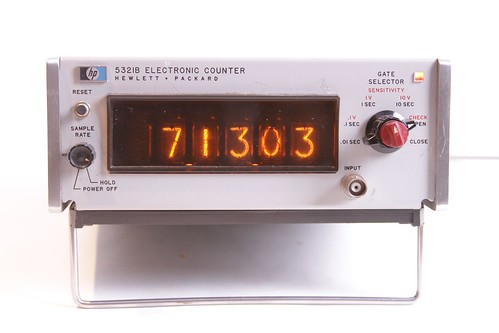
One of our favorite longstanding projects– which we dropped a hint about some time ago –is converting old HP Nixie-tube counters into happily glowing Nixie clocks. Here’s how we do it.
We’ve converted a few different types, but our favorite clocks come from HP 5321B and 5221B electronic counters. These frequency counters were produced from about 1968-1970, in that brief window of time where the control electronics had transitioned from discrete-transistor logic to integrated circuits, but Nixie tubes were still the preferred display technology. (By 1971, HP’s catalog was full of counters with high-tech light-emitting diode displays.)
You can often pick up counters like these at eBay or at various places that sell surplus electronics, and as they are rather obsolete, they’re usually quite inexpensive. The condition that old electronics like these arrive in can vary greatly. We’ve acquired some that were barely repairable and mostly corroded, and others like this one that still have the calibration seal intact.
While shopping, you should be aware of is that counters that look like these may actually be populated with 4, 5, or 6 tubes. The good news is that they can be expanded even at this late date, by adding three chips and a tube (per digit) to the main circuit board. We’ll get to that in a minute, but the point is that it’s straightforward to combine parts from multiple units of the same model.
Under the top cover, you can see the main circuit board, which contains the display logic and the tubes themselves, socketed.
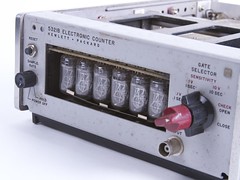
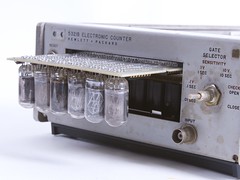

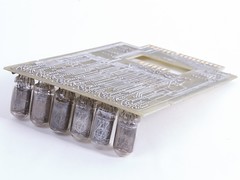
The main board is anchored in place with a couple of slot-tabs, and you essentially need to bend the board over a couple of tabs in order to slide it out. The nixie tubes hang upside down from the board, and have numbers that might seem upside down if you didn’t know this.
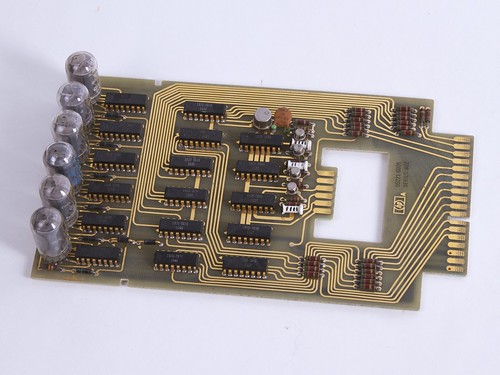
The board itself is something of a masterwork. The traces are thick and gold plated. It’s soldered on the back side only, apparently by a dip-solder process. The chips are all now-generic types, but under HP part numbers (“1820-0093…”) and the protruding letters “hp” are molded right into the cases of each package. (You can see this photo in monstrous resolution here, if you’re so inclined.)
There are three rows of chips on the board. The ones furthest from the tubes are cascading decade counter chips, the middle row are buffer chips, and those closest to the tubes are the Nixie driver chips.
For a little background, consider how this board works as part of the overall counter instrument. The input clock signal to the board goes to one decade counter chip (the rightmost). When that chip overflows, i.e., counts up from 9 to 0, it also outputs a “carry” signal to the next chip, which then counts at 1/10 the rate, and so on. By doing this, the decade counter chips, together, form a record of how many total input signals have been received since the instrument started counting. After the instrument counts the input signal for a set period of time (the “gate” time), the values from those chips are loaded into the buffer chips, and the decade counters are reset to zero. The buffer chips output their stored values continuously to the Nixie driver chips, so that it can display the last count.
You’ll notice that the back row appears to only have five decade counter chips on it. It actually has six, where the sixth is the large metal can. This is the decade counter chip for the rightmost decimal place on the counter, which has to count ten times as fast as its neighbor. For this counter chip alone, HP used a higher performance version (in the metal can) that can count faster than the others.

And, here’s the block diagram from the manual showing how those pieces work together. The busses between the decade counter, buffer, and Nixie driver chips are 4-bit wide, binary coded decimal.
(They don’t make ’em like they used to, referring to the manuals of course.)
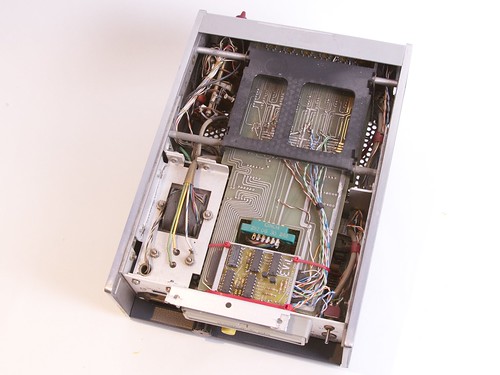
Now, to begin modifications. The basic fact that we need to overcome is that this is a decade counter– each digit rolls over from 9 to 0, while we want a digital clock to roll over from 59 to 0, 59 to 0, and 12 to 1.
Operating the clock, we count at 1 second intervals, triggered on internally-generated 1 s gate signal, counted down from the internal timebase. We could in “open” gate mode, where we do not reset the count every time that there is a new gate. (In other words, we’re using this clock like a pulse counter rather than like a frequency counter.)
To that end, we cut traces on the circuit board, and route signals to our own circuit board, strapped into the chassis with cable ties and insulated by foam rubber. The board has four 7402 “Quad Input NOR Gate” chips onboard, along with a 74107 “Dual J-K Flip Flop” and a couple of transistors.
For the two rightmost digits, the secondson our clock, we look at the binary-coded decimal output of the counter chips, and detect when the displayed characters are “60.” That’s actually simpler than it sounds, since we only need to detect the “6,” and that is represented by the first low on two specific pins of the decade counter BCD output.
Once we’ve detected the “6,” we reset that chip to zero and send the carry signal to the next chip over, the first digit of the minutes on our clock.
The reset input for the chip takes a positive going pulse of 3 microseconds, driven through an npn transistor. We generate that pulse with a simple one-shot, built with two NOR gates– a classic example of what is known as MML, “Mickey Mouse Logic.”
For detecting 60 minutes, we do the exact same thing, carrying an output to increment the hours every 60 minutes.
It is somewhat more complex to display the hours. The “native” counting order of the decade counters is 0,1,2,3,4,5,6,7,8,9,10,11,12,13 (…). However, we don’t want to display zero; we want to wrap around and display the count as 1,2,3,4,5,6,7,8,9,10,11,12,1,2 (…).
We actually did this by rewiring the ten outputs of the Nixie decoder driver, between that chip and the tube (for the 1-hour place), so that the tube is lit up as “1” when its input is BCD0, and so forth. We then need to detect BCD9 (again, two specific lows detected with a NOR gate), to generate the carry signal to the ten-hours. After the chip outputs BCD9 (displaying “0”) it increments to BCD0, where it displays “1”– resetting itself.
For rolling over from 12:59 to 1:00, we want to detect a reading of “13” on the display. This requires actually looking for an “internal” reading of BCD1,BCD2. This is easily detected with a fourth NOR gate, reading the low signals that indicate both “1” and “2.” The output of this gate resets the two hour digit counters back to zero– which is displayed as 01. Zero-blanking, to just display “1:00” canbe accomplished by simply disconnecting the trace that would otherwise light up the 0 on the ten-hours digit.
One might alternately wish to build this into a 24-hour clock. That would be equally straightforward, by detecting BCD “2,3” as the reset condition.
Here’s the circuit board alone; nothing special about it, with one possible non-technical exception.
As we said, making these clocks has been a longstanding project for us. And, this right here is the very first circuit board to bear the Evil Mad Scientist badge; it dates back to 2003.

There’s one other feature on the circuit board that we haven’t discussed yet, which is that it can recognize and indicate AM and PM times. Remembering which state we’re in requires a single bit of memory, for which we use that flip-flop chip. We detect the switch from AM to PM times (and vice versa) when the clock reads “12”, meaning that we read the BCD “1,1” on the two leading digits, using one NOR gate.
The state is stored by the flip flop, and indicated using the “Gate” neon indicator, that you can see in the upper right corner of the front panel– the neon light is on for PM times. You can’t drive the neon bulb directly from the flip-flop chip, so we actually hijack the circuitry that originally drove that indicator. The “Gate” indicator signal comes from the timebase board, not the main counting/display board that we’ve talked about so far, so the output from our flip-flop goes to that board, where we cut a trace and use our AM/PM signal instead.
Speaking of neon bulbs, there are two additional neon bulbs that we have added to the clock, which are the small “decimal point” lights that you can see in the photo above, separating hours, minutes, and seconds.
The separators are plain miniature neon bulbs, and each has a series resistor hidden in the heat shrink tubing. They are wired in parallel, across line voltage (live to ground) so that they’re always on when the clock is switched on.
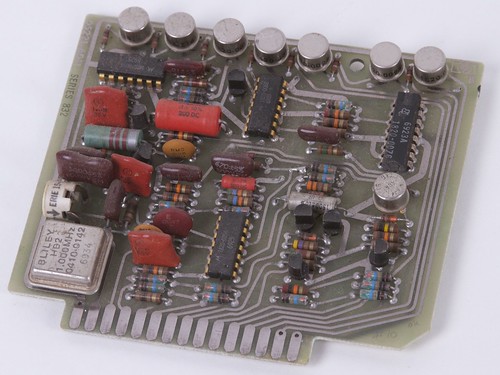
This is the timebase board. There are similar frequency counters that use the line frequency as their reference, but this board is based around a 1 MHz quartz crystal. The seven cans at the back of the board are high frequency decade counter chips like the one found on the main board. They count down the timebase, giving 100 kHz, 10 kHz, 1 kHz, 100 Hz, 10 Hz, 1 Hz, and 0.1 Hz output signals that can be used for gating and frequency counting.
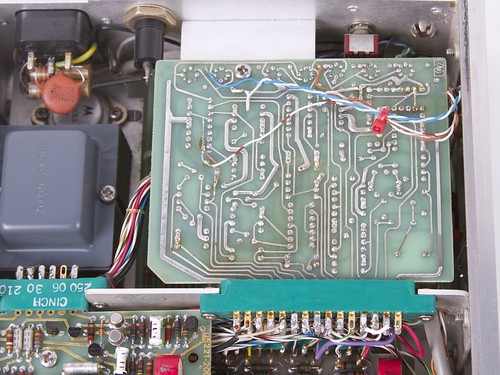
Here’s what the underside of one of those boards looks like, as installed in the counter with our modifications. The circuit board color is slightly different in this particular unit, but it’s the same otherwise.
The striped wire going to the middle left of the board is carrying our AM/PM signal to the logic that drives the front-panel neon bulb. The other wires are where we tap off the timing signals for our own purposes. The most important of these signals are the 1 Hz and 1 kHz signals. The 1 Hz signal is re-routed as the input to the counter– the signal that we actually count to give the time — and the 1 kHz signal is an auxiliary clock that we use as part of the time setting process.

We repurposed the rear-panel “Storage” switch as another part of the system for setting the time.When “storage” is off, the 1 Hz timing signal goes into the input. When “storage” is on, the 1 Hz signal is disconnected, but the pressing the front-panel “Reset” button advances the clock at 1 kHz, using the other signal that we picked off of the timebase board.
So, to set the time precisely, you can flip up the “storage” switch, press “Reset” until the time is within a minute of the actual time, and then flip down the “storage” switch (to start running in real time again) when the clock displays the right time.
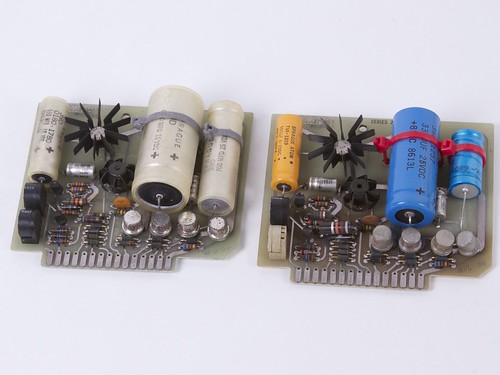
These counters are relatively old, and for the most part work surprisingly well considering their age. One place that failures can commonly crop up is on the power supply board. The one on the right had a resistor burn out at some point, which we replaced, and we also decided to replace its large electrolytic capacitors with ones 15-20 years younger.
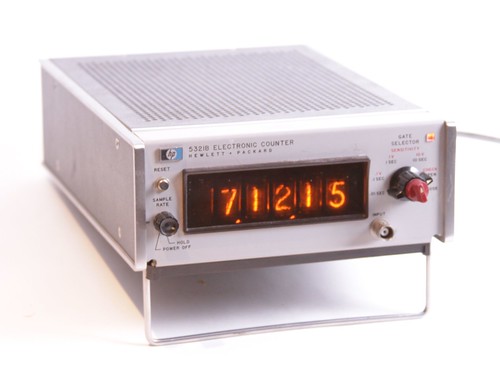
And that’s about the size of it.
These certainly aren’t the only old frequency counters that can be made into clocks, but the particular blend of technology here– easy to use TTL chips and Nixie tubes –is a friendly one for hacking, with potentially neat results. If you’d like to get into it, just grab a few of these old guys and poke and prod and see how they work. Get the manuals if you can, and keep in mind that there’s plenty of line voltage, or even high voltage for the Nixie tubes, coursing through the veins of these boxes.





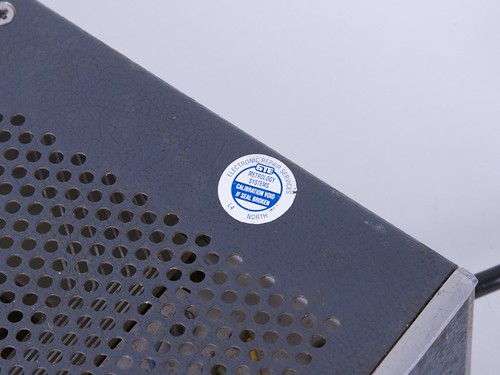
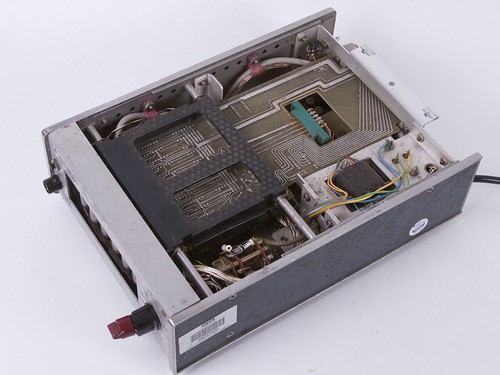
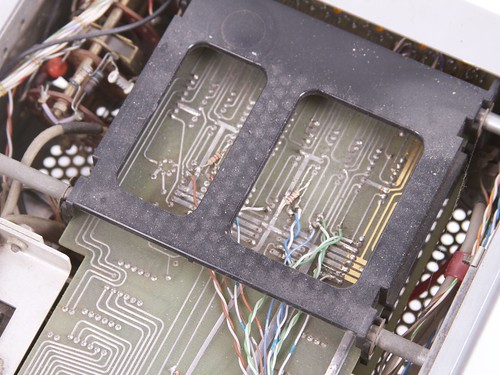

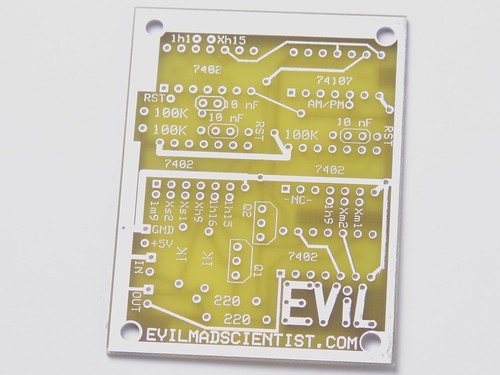
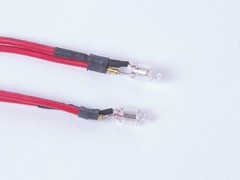
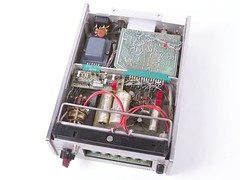
Very cool! I’ve done this as well; last year I bought a dud frequency counter at the Electronics Flea Market, the power supply and tubes worked but the counting circuit didn’t.
The counter had 5 digits, with a 74141 decoder/driver for each digit and a 7475 latch feeding into each decoder. I desoldered the 7475s, built a little circuit with an AVR on a perfboard, and wired it directly to the inputs of the 74141s.
The counter had only 5 tubes, so I could show seconds, minutes, and one hours digit. However, there was a little neon "overflow" lamp to the left of the display. I replaced it with an NE-2 neon tube that looks like a "1". The leads were long enough so that I could position the tube next to the leftmost digit, and the clock could now tell 12-hour time. (I put an LED where the overflow lamp was, to indicate AM/PM.)
Here’s a photo gallery of the build:
http://www.flickr.com/photos/74hc595/sets/72157622429434840/
This reminds me of when I was a kid. (late 80s). I desperately wanted an oscilloscope (and a freq counter too actually) but there was no way I could afford one. I found a bunch of old Popular Electronics magazines from the 70s on a shelf meant for kids to cut pictures out for school projects at the school library. The librarian let me have them. One of the projects was a board to allow one to watch TV on an oscilloscope. I remember the introduction of the article said that circuits to make TVs into oscilloscopes were published everywhere so this article would be about the opposite. This really annoyed me because old TVs were easy to get but I had no idea where to find an oscilloscope I could afford on my $5/week paper route. (It was a once per week classifieds paper) I had a few TVs because every time I saw a better one than the one I had at a garage sale I would buy it.
Now I have two frequency counters and an oscilloscope. I can read any one of a number of webpages about turning a TV into an oscilloscope or watch it on YouTube if I wanted too though I wouldn’t. (not enough bandwidth). Still I can’t help but think a frequency counter for a clock is a bad trade.
I suppose it doesn’t really matter when the meter is so far gone that all that is worth saving is the Nixies and the case but maybe for the nicer ones a better use would be to find a kid with an electronics interest and donate??
Sorry, clicked the wrong button. Parent wasn’t meant to be a reply to the grandparent but rather a comment of it’s own.
Yes, these frequency counters are 40 years old now, and are very truly obsolete as frequency counters– easily replaced by $10-$20 of parts. However, they have extreme value for their tubes, the tube-driving hardware, and the solid cases. It’s a big win for these old counters to make this conversion.
Windell H. Oskay
drwho(at)evilmadscientist.com
http://www.evilmadscientist.com/
Who says you can’t keep it as a counter _and_ have modern electronics inside? You could gut it and use the case and the display tubes for a frequency counter with modern electronics. And have a switch or something you could flip to get clock mode. Have your cake and eat it too.
I really like the options on your clock! ;) The ability to stop and start the flow of time with the On Off button is obvious, but how does KHz time and MHz time differ? Also, what happens if you kick it into Hi time as opposed to Low time?
Great idea, this would make a nice clock for the electronics lab, just don’t add the decimal points and I think most people wouldn’t even notice it’s a clock ;-).
Just one thing I wanted to add: 24-hour clocks usually don’t count from 1 to 24 but from 0 to 23 (midnight is "zero o’clock", we actually say "null uhr" in Germany), so resetting the hours is as straightforward as resetting the minutes, just use a single NOR gate to reset both counters (one input to hour1-bit2, the other to hour10-bit1 [bit numbers counted from 0]).
It’s a shame that all of this old test equipment is getting turned into clocks. Vintage oscilloscopes, frequency counters, and voltmeters are fun to use and much more expensive/rare than clocks.
It would have been neat if you had built something that you could plug into the frequency counter which would generate frequencies that could display the time. I wouldn’t have been that much more difficult, it wouldn’t have destroyed the frequency counter, and it would have been portable to every other frequency counter ever made.
For many instruments that’s true; I’ve seen some lovely and irreplaceable old instruments turned into modern things– as simple and offensive as case mods for modern gaming computers.
But it’s hard to argue that these particular counters have more value as counters than as clocks. Nixie tube clocks tend to go for hundreds of dollars. Most of these counters cost $20 or less. By refurbishing them and repurposing them, we’ve increased their value by an order of magnitude.
I *use* frequency counters. I know very well what they’re worth, both as counters, as potential clocks, and as sources of spare parts. And the sad truth is that these particular guys are painfully obsolete as counters. Easily replaced by $20 worth of parts. And the newer versions of these (1971 onwards) with the LED displays are more reliable and simply *better* as frequency counters.
So yes– it’s worth considering whether an old instrument has more value intact than as a project. But in this particular case, I must say that I feel like I’ve done a good thing to rescue something wonderful from a junkpile.
Your idea about creating an add-on module to display the time by counting an actual frequency is interesting. Not sure how well these guys would do with that, but I do have an elegant older HP nixie frequency counter that *is* too marvelous to rewire. Might be worth making an external module for, though.
Windell H. Oskay
drwho(at)evilmadscientist.com
http://www.evilmadscientist.com/
At least it didn’t get turned into a PC case :)
Windell – I’m curious which older counter(s) you have that you’re not willing to cut up. After reading this posting and while back (and thinking along these lines for years), I’ve acquired a number of older HP counters – not these 1970’s models, but the generation before. I currently have 5512A, 5532A, 5233L, 5245L counters – all of which have problems – not surprising since they’re going on 50 years old! After refurbishing these, I do intend to turn them into clocks – but via an external board that generates timebase and count outputs. Then of course there’s the tube generation from the decade before – but those machines are really hard to find these days!
I started a project that would output frequencies that could be displayed directly by the frequency counter. It turned out that accuracy was going to be a big problem so I gave up on that method.
Instead, I went to a pure counter-driven method. I tapped into the reset line so that I could reset the count to 0 at will. Once a minute (and in other situations, like when setting the time, or when displaying the date) it reset the count and quickly output the right number of pulses to display the time. The rest of the time it just output one pulse per second to update the seconds count.
This was minimally invasive to the counter – I didn’t have to cut any traces, just added a wire to the reset switch itself. I stuck a rotary encoder and a switch into spare holes in the back panel for use in setting the time.
I got it working well on the breadboard but never took it beyond that, and managed to screw something up electrically and didn’t have the time to fix it. Wish I’d been a little more of a hardware guy and built a circuit board, because I have a handful of suitable counters I bought off the scrap pile at work a few years ago.
Interesting. Now what about making it connect to the atomic clocks and have it automatically set the time?
And could you expand it to include Month/Day/Year display?